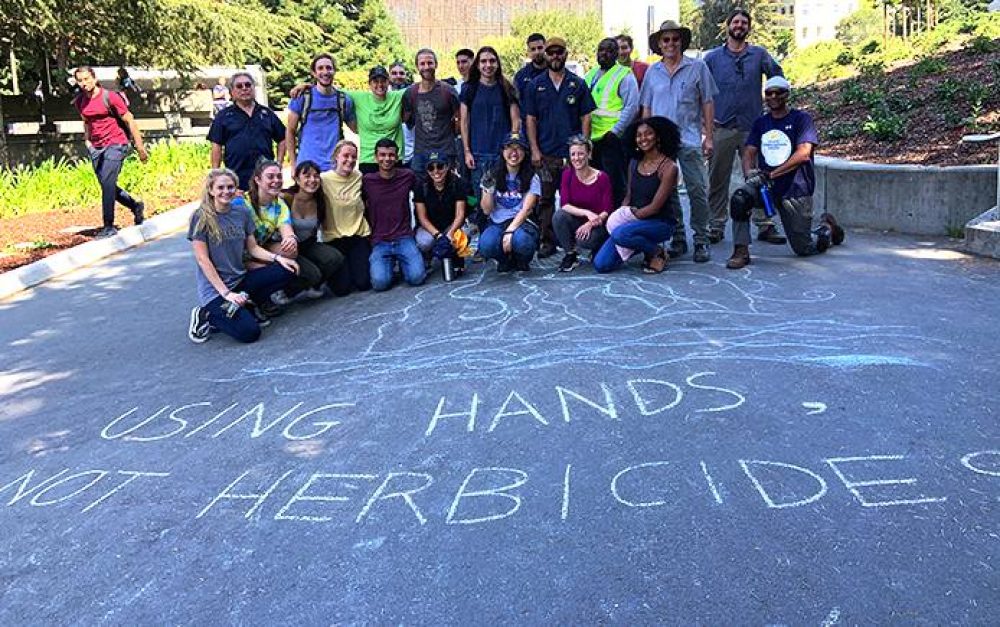For the last few years, Herbicide-Free Campus has been in the weeds, literally, working to eliminate herbicides on campuses across the country. In 2019, University of California (UC) President Janet Napolitano temporarily banned glyphosate at all 10 UC campuses, and established a UC Herbicide Task Force to provide recommendations moving forward.
For the last few years, Herbicide-Free Campus has been in the weeds, literally, working to eliminate herbicides on campuses across the country. As a result of student efforts, in May of 2019 University of California (UC) President Janet Napolitano temporarily banned glyphosate at all 10 UC campuses, and established a UC Herbicide Task Force to provide recommendations moving forward.
Then, in January of 2020, Napolitano approved recommendations made by this task force to “restrict the use of some toxic pesticides and increase transparency across the university’s 10 campuses.” Napolitano has agreed to temporarily continue the suspension of glyphosate on UC campuses, but this is only until Integrated Pest Management (IPM) plans are implemented.
While this is a step in the right direction, there is still a lot of ground to cover — Herbicide-Free Campus student activists have been pushing the UCs to commit to transitioning to all-organic land care maintenance by 2025.
IPM…the good and the bad
While IPM does restrict the application of highly toxic pesticides, it is not entirely comprehensive; It lacks strict oversight and the interpretation of IPM can vary widely. Essentially, IPM permits the use of pesticides only as a last resort and after review by local IPM committees. But the extent to which a chemical is a “last resort” and the integrity of these committees is up to interpretation by the campuses.
One positive aspect of the task force’s recommendations will be the tracking of pesticide usage. A pesticide use authorization software will be developed to report the location and timing of campus pesticide application — something that is not happening at present.
A patch vs. a fix
Simply, as is often interpreted, IPM is a band-aid for a broken arm. The system still permits the use of toxic pesticides rather than encouraging us to envision and create solutions that end our reliance on harmful chemicals. The recent recommendations require that within one year, all pesticides must be applied by California licensed and certified applicators. But these recommendations will not address the much larger systemic problem of our dependence on synthetic pesticides for land management.
Organic land management however, would upend the current system by focusing on soil health, soil biology, and organic-based herbicides. The only chemicals that can be used in organic land management and agriculture are the “minimum risk pesticides [that] pose little to no risk to human health or the environment.” These chemicals are OMRI certified or 25b exempt, and used for the support of natural soil health.
The task force’s recommendations are just one step toward our ultimate goal. The overturn of the status quo would mean changing our aesthetic goals by letting native plants grow and not demanding perfectly manicured lawns. It would mean embracing plant diversity as fundamental to ecosystem resilience, and pulling weeds, mulching, and building healthy soil in order to sequester carbon. It would mean public understanding and taking ownership over the fact that we all have a stake in the way landscapes are managed.
What about university ag land?
This discussion and movement is largely centered on land we see on campus, such as lawns that students study or lounge on, and vegetation that lines paths and sidewalks throughout campus. But what about university-owned agricultural land? Schools like UC Berkeley or UC Davis own acres of this, deemed by the Hatch Act of 1887 as “agricultural experiment station[s] under the direction of each state’s land-grant college.” While this land was originally intended for research, it is currently being used as sites for unregulated chemical testing.
This land, not necessarily on the main UC campuses, is exempt from any of the decisions or regulations discussed above — no IPM, no organic land management, nothing. The harmful pesticides atrazine and paraquat are just a couple of the toxic chemicals currently being used on UC-owned ag land.
The University of California, which prides itself on its commitment to sustainability, has the opportunity to join other universities such as Harvard, the University of Colorado at Boulder, Yale, University of Pennsylvania, and other institutions that have drastically reduced or eliminated the use of herbicides on campus.
What started out as two UC Berkeley student athletes picking weeds around their practice fields to avoid being exposed to glyphosate, has turned into a national campaign operating in 15 schools across eight states. We know that this movement to transition every campus in the country to organic is not only possible, but necessary. Learn how to get involved with Herbicide-Free Campus here.







